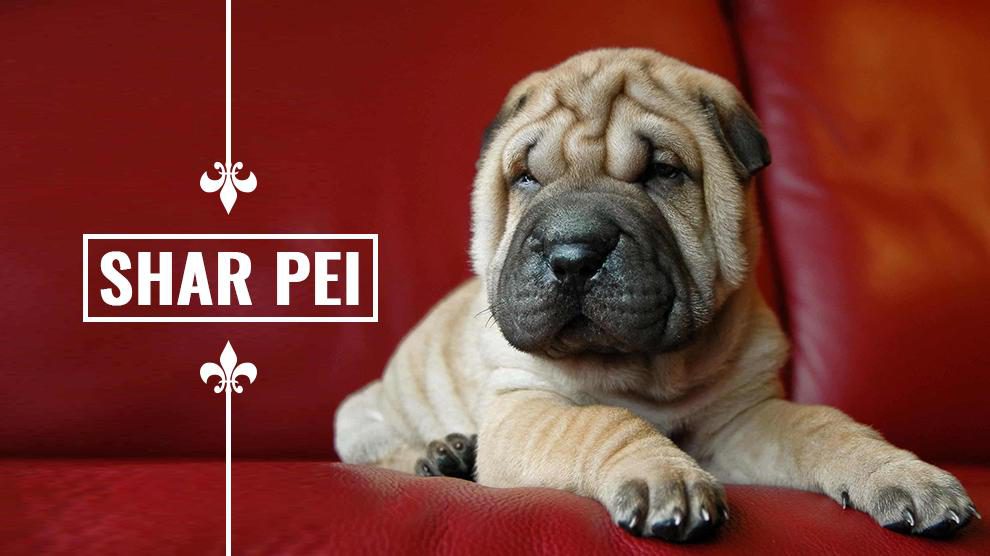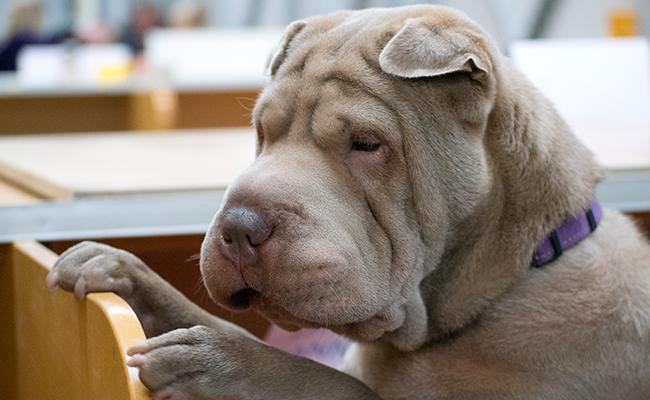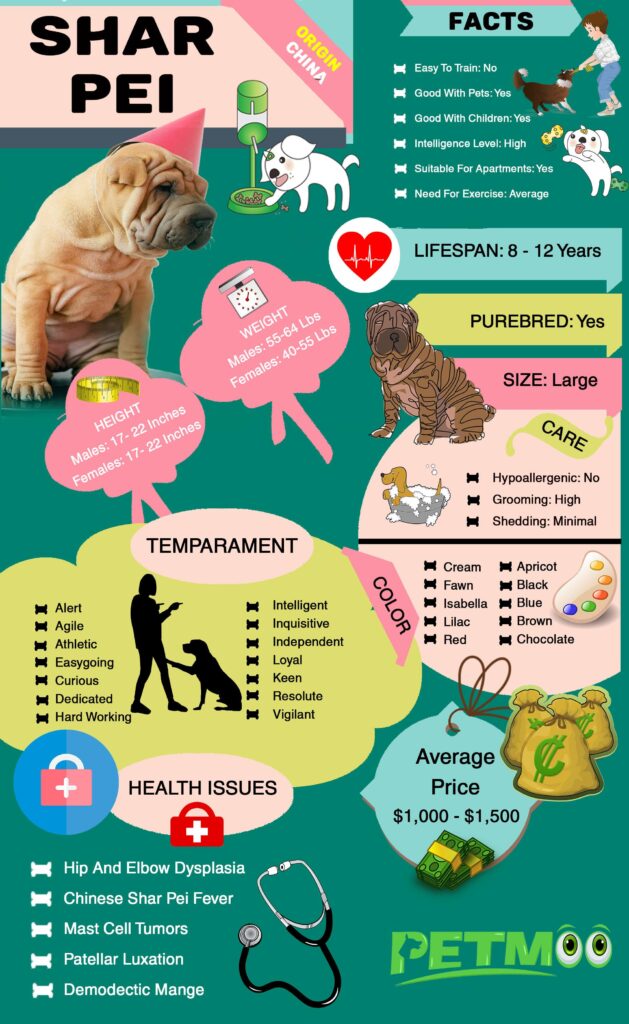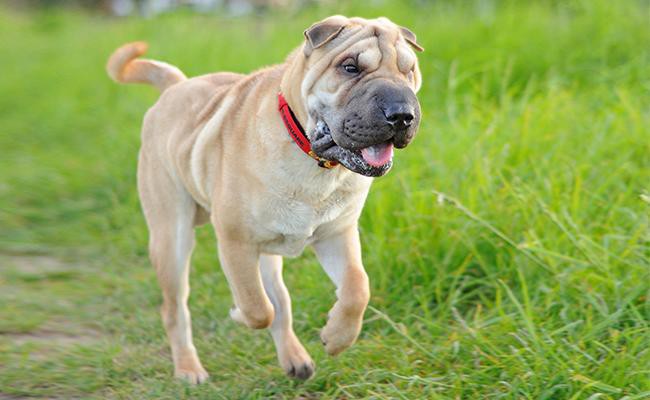Dog Pregnancy Calculator And Timeline
Is that a pile of towels or raisins with legs? No… It’s Shar Pei (meaning ‘sandpaper skin’ or ‘harsh sandy coat’) with lots of wrinkles and sandy skin.
They are certainly one of a kind, completely bizarre-looking, devastatingly adorable and have an interesting history to match.
The once-seen-never-to-be-forgotten dog Shar Pei (both Chinese and American varieties) is with a host of odd physical characteristics.
The first sight with Shar Pei will certainly hold a divine feel and you will end up spotting your soul pet.
Shar Pei Breed Characteristics Sheet
- Origin: China
- Size: Large
- Dog Breed Group: Molossian: Mastiff (FCI)/ Non-Sporting (AKC, CKC), Utility(KC), Northern Breed (UKC)
- Purebred: Yes
- Lifespan: 8-12 Years
- Height: Males: 46 – 56 Cm(17- 22 Inch), Females: 46 – 56 Cm(17- 22 Inch)
- Weight: Males: 25 – 29 Kg (55-64 Lbs), Females: 18 – 25 Kg (40-55 Lbs)
- Coat Appearance: Horse Shoe Coat, Brush Coat, Bear Coat
- Coat Colors: Apricot, Apricot Dilute, Black, Blue, Brown, Chocolate, Chocolate Dilute, Cream, Cream Dilute, Fawn, Fawn Dilute, Isabella, Lilac, Red, Dilute Red, Fawn Red, Sable
- Temperament: Alert, Agile, Athletic, Easygoing, Curious, Dedicated, Hard Working, Intelligent, Inquisitive, Independent, Loyal, Keen, Resolute, Vigilant
- Good With Children: Yes
- Intelligence Level: High
- Good With Pets: Yes
- Hypoallergenic: No
- Grooming: High
- Shedding: Minimal
- Barking: Barks When Necessary
- Suitable For Apartments: Yes
- Need For Exercise: Average
- Easy To Train: No
- Good For First Time Owners: No
- Health Issues: Hip And Elbow Dysplasia, Chinese Shar Pei Fever, Mast Cell Tumors, Patellar Luxation, Demodectic Mange
- Litter Size: 4- 6 Puppies
- Average Price: 1000 – $1200 Usd (USA), £700 For Kc Registered £600 For Non-Kc Registered
Shar Pei History
There is no consensus among Shar Pei clubs about their origin and there are several theories. Tradition denotes the small village of Tai Lai in Kwangtung Province, Southern China as the origin of the Shar Pei.
According to experts, the first version of the Shar-Pei breed should have been bred during the times of the Han Dynasty. Ancient Pottery and statuettes of wrinkled dogs with the square-shaped body and curled tail – so-called “tomb dogs” – are used as evidence to support this theory.
Chinese art of that time is characterized by depiction of Chinese dog breeds such as Chows or Pugs.
Italian explorer Marco Polo’s journal of his travels in China published in 1271 are used to validate the supposed ancient origin of Shar Pei.
The similarity of a Chow Chow and a Shar Pei is undeniable. And, Chow is the only native hunting breed in China which was also used as shepherd dogs and as companion dogs as well.
And our Shar-Pei is also known to possess those talents.
In the late 1950s, the Chinese communists declared dogs as non-productive, conventional comforts and ordered their large-scale extermination. The center of Chinese Fighting Dog history moved or rather was driven into Hong Kong by the Chinese government due to the increase in the tax on dogs that was designed to discourage dog ownership.
The canine refugees from China swelled the dog population of Hong Kong as this coastal city provided one of the few safe havens for dogs in all of China.
Registration information and ancestry were virtually non-existent and records were destroyed or lost during the Chinese Communist Revolution.
While attempting to re-create or safeguard these Chinese Fighting dogs, some of the Hong Kong breeders crossbred these “best types existing” dogs with Chow Chows, Bull Mastiffs, Bulldogs, Pitbulls, Boxers and possibly other dog breeds and unintentionally (or intentionally?) creating a new breed – the latest Shar Pei catering to Western audience particularly America.
The Shar-Pei has since developed into two separate lines. The pedigree Chinese Fighting Dog remains essentially unaffected as the Chinese Shar-Pei, which still exists.
The American Shar-Pei is found in the U.S. and had its origin in Hong Kong in the late 1960s. Actually, in Hong Kong dog shows today, these two types of Shar-Pei are presented and judged separately.
Already falling in love with the Shar-pei? We don’t blame you! Keep reading
Shar Pei Size And Lifespan
Size
- Height – Males: 46 – 56 cm(17- 22 inch), Females: 46 – 56 cm(17- 22 inch)
- Weight – Males: 25 – 29 kg (55-64 lbs), Females: 18 – 25 kg (40-55 lbs)
Lifespan
A healthy Shar-pei should expect to enjoy a life expectancy of between 8 – 12 years when properly cared for and fed a good quality diet to suit their ages.
Shar Pei Coat Color And Appearance
The breed standard says that the tremendously harsh coat is one of the most distinguishing features of the breed, though, the coat appears healthy without being shiny or lustrous.”
“Shar-Pei” literally translates to ‘sand skin’. It refers to the two very special qualities of the Shar-Pei coat: shortness and roughness. One of the interesting details of the Shar-Pei is the difference in coat types.
1. Horse coat Shar Pei
‘Horse hairstyle’ coat types have the coarsest and shortest hair. Their appearance also changes most dramatically from puppy to adult.
They’re little balls of crinkled pups during puppyhood. However, as adults, the wrinkles largely disappear except around the face and they often appear to have smoother skin with a slim and muscular build.
They shed less than other types as they are not double coated and are less adaptable for cold weather.
When adopting a horse coat Shar Pei puppy, it is important to remember that they often lack the wrinkly appearance and cute expression and that was once so endearing when they were a puppy.
2. Brush Coat Shar-Pei
They have slightly softer and longer hair than their horse coat dogs. These adorable, bonny chocolate boxes retain somewhat puppy-like appearance as adults, and hence are the most popular type.
They’re stockier and heavier than horse coats.
3. Bear Coat
This rarest variety of Shar-Pei is the outcome of recessive genes- both (the male and female should carry the recessive gene for this coat type).
Bear coats are more like the brush coat in appearance and personality but have a long top coat which is longer than 1 inch.
Although undeniably charming, it is considered an error by major Kennel Clubs. Hence it is better to avoid this Shar-Pei if you want to go for a show-ring dog.
4. Spotted Coat
Spotted Shar-Pei do pop up in litters occasionally. This color pattern is a disqualification in the AKC standard, making them only a pet quality puppy.
Keep in mind, you have to pay more money for a rare coated Shar-Pei, especially when the color or coat type is an AKC disqualification.
Appearance
They are medium-sized, compact dog with a square, short loins and show a lot of bones. Their heads are quite large with a characteristic “hippopotamus” muzzle but not so much lopsided from the rest of their body.
They have relatively loose skin, well-padded in the lips and top of the muzzle, “Scowly” expression, coarse bristly coat, no longer than one inch. Females may be a little longer in the body and smaller in stature than males.
Shar Pei Temperament
♦ Shar Pei’s have blue and black clapper. Let’s start with that.
♦ At least once a day, you’d find yourself with your entire fist in his mouth (at his persistence), and it has to be one of the craziest spots on earth.
♦ Don’t ever miss the chance to explore one of these dogs’ humid caves.
♦ They are the fun-loving, loyal, even-tempered family-favorite dog. These dog breeds are also very sharp and shrewd; they can sense what they are supposed to do before being told.
♦ Meanwhile, they are also well-mannered, fun-loving fluffy pooches. It’s more of a laid-back and friendly dog that loves being around people.
♦ In general, your Shar Pei will be smart and intelligent while thrives on interacting with its owner, household family members and generally all the people it loves.
♦ The Shar-Pei is a bit of Lord Muck. They are generally independent and strong-willed. They are naturally reserved and aloof around people they don’t know.
♦ The shade they throw at you when you try and teach them a new trick will perhaps make you embarrassed for ever thinking it was cool.
♦ With looks like they have, it is impossible not to have a sense of humor.
♦ They have a little trouble eating and drinking due to their thick-lipped hippopotamus mouth.
♦ Most of the water in their bowl ends up on the floor because they use their mouths kind of like a nozzle and plenty of dripping from their portobellos.
♦ They also gasp their food. Some Shar Pei’s would lose pieces of sweet potato in their jowls and try to retrieve it for hours.
Who Gets Along With Shar-Pei Dogs?
- Those who seek a good guard dog who will also interact with the family
- Family with kids
- Active household
- Singles and seniors
- Apartments, condos, houses with/without yards
Adaptability
- Apartment Living – Yes
- Good For First-Time Owners – No
- Sensitivity Level – High
- Loneliness – Hates To Be Left Alone
- Cold Weather – Average
- Hot Weather – Average
Friendliness
- With Family – High
- Kids – High
- Other Dogs – High
- Cats – Good, If Raised Together
- Other Pets – Good, If Raised Together
- Strangers – Suspicious
General Behavior
- Independence – Average
- Dominance – High
- Combativeness – Non- Aggressive
- Indoors – Active
- Outdoor – Highly Active
- Territorial – Yes
- Easy Of Transportation – Good
Shar Pei Training
- Trainability – Hard
- Intelligence – High
- Memory – High
- Mouthiness – High
- Prey Drive – High
- Wanderlust Potential – Low
The Shar-Pei puppies are typical little goofballs! These puppies are pleasant, playful and puckish.
It’s highly recommended that your pet should be exposed to all kinds of noises, situations, people and other dogs as possible so as to make sure they get a friendly dog once their pup reaches adulthood.
They are active little people pleasers! Friendly and extrovert dogs, they can be easily distracted and bored, so keeping the training interesting is important.
When done with good attitude and patience, the results of training Shar Peis can be truly rewarding.
Shar Pei’s are really intelligent. Nobody ever had one that couldn’t be house trained within the first day.
For instance, when you feed your Shar Pei at 9 am and 9 pm. If his bowl is still empty at 9:01 he will come to remind you. How does he tell time? that is a subject of another discussion
Shar Pei’s are known to get bored to tears easily. They are said to do well as companions to apartment dwellers but they require exercise.
This Shar Pei puppy is taking his first steps into a larger, brighter world. Remember, the fragile, feeble steps of Shar-Pei puppies are the foundations upon which bold, determined Shar-Pei dogs are built.
Taking your Shar Pei everywhere with you, visiting all your dog friends and getting your dog used to being around other dogs will ensure that you won’t have a shy or scared dog.
Try fetching games with your pup using a stick, ball, soft toys or Frisbee –anything to get your pet to chase the object and bring it back to you– is a great exercise and teaches your dog to come to you.
Shar Peis will require lots of self-exercise and regular walks to have a strong musculoskeletal system and to keep their weight down.
Shar Pei Food
General guidelines
♦ We recommend feeding Shar Pei at least twice a day. This decreases the incidence of bloat and begging behavior.
♦ For pups up to 3 months, feed 3 meals per day. For 3-6 months pups gradually decrease from 3 meals to 2 meals per day. For pups over 6 months, 2 meals per day are more than enough.
♦ Most Shar Peis are more active in the summer and less active in the winter.
♦ This means you have to increase the amount of food when activity increases and reduce the amount of food you feed during the times of the year coinciding with decreased activity.
♦ The reverse may be true with bear coats and brush coats who tolerate the winter much better than horse coats.
♦ We generally recommend the use of ceramic or stainless steel food and water bowls. We occasionally see a depigmentation on the front of the chin and muzzle in those dogs that have plastic or vinyl bowls.
♦ This may be due to a contact allergy which can happen because of the release of chemicals from the plastic/vinyl over time.
♦ We suggest that reducing the diet with canned pumpkin (not pumpkin pie filling) is a good way to fill the dog up without increasing calories rather than starving the dog.
♦ Try not to give canned dog foods, table scraps, pork, steak, chicken or turkey bones. The only bones allowed are large beef knucklebones.
Shar Pei Grooming And Shedding
- Coat Density – Normal
- Length – Medium
- Texture – Straight
- Brushing Frequency – Daily
- Trimming/Stripping – No
- Hypoallergenic – No
- Shedding – Minimal
Make grooming your Shar-Pei as a part of your regular routine and pooch-pampering sessions to keep his coat shiny, healthy and tangle free.
You’ll want to ensure you take care of their coats as much as necessary. This means that you need to brush their coat on a daily basis to trap loose fur before it sheds.
Make sure to use a brush that can reach inside layers of the coat. How often your pet will need a bath depends on the type of activities the dog is involved in. It’s best to bathe your dog only when your dog is really dirty.
As a rule, when that “doggy smell” starts, it’s time for a bath.
Care should be taken when cleaning and drying the many wrinkles and folds characteristic to this breed; moisture, dirt, and debris can accumulate within the folds, providing a breeding ground for bacteria and yeast.
As with any pet dog, you’ll also need to clean his teeth and ears regularly to avoid infection. Trim his toenails regularly (just don’t trim too short) and health checks regularly are other grooming that golden labs need.
Shar Pei Health Problems
Major concerns:
- Hip dysplasia: You’ve probably heard of hip dysplasia, when the hip joint (coxofemoral joint) fails to develop normally, either due to one or several developmental problems, environmental or nutritional factors and this leads to arthritis, problems in mobility and lameness.
- Elbow dysplasia: multiple developmental abnormalities of the elbow joint which causes damage to the cartilage surface of the joint – a process called osteochondrosis or OCD.
- Chinese Shar-Pei Fever: also known as Familial Shar-Pei fever, this is an immunoreactive disorder – autoinflammatory syndrome (not autoimmune) found only in Chinese Shar-Pei dogs characterized by random inflammatory events with one or more bouts of unexplained fever, sometimes with Swelling around a joint with or without inflammation or muzzle, Abdominal pain, “roached” back, reluctance to move, mild vomiting or diarrhea.
- Mast Cell Tumors: Also known as mastocytomas, they are one of the most common types of skin tumors found in dogs.
Minor concerns:
- Patellar Luxation: This common orthopedic condition in dogs is due to the dislocation of the kneecap or sliding out of its normal anatomical position. This may cause the progression of osteoarthritis, varying degrees of lameness and pain.
- Demodectic Mange: Demodex” or “red mange” is the most common form of mange in dogs. This is caused by the Demodex mites resulting in hair loss across the body (alopecia), intense itching, scaly skin, and sores.
Shar Pei Names
| Male | Female |
|---|---|
| Bao | Bamboo |
| Buddha | Lotus |
| Chang | Lin |
| Emperor | Jing |
| Fortune | Ming |
| Fushi | Meyli |
| Peking | Tai Chi |
| Paddington | Tofu |
| Squish | Yin |
| Shen | Yuan |
Shar Pei Price And Breeders
Shar Pei Price
You should expect to pay between $1000 to $1200 but can go all the way up to $1500 for your Shar Pei puppy depending on the pedigree and the breeder. Always make sure to buy your puppy from a reputable breeder or look at local dog shelters.
Average Price in the UK – £700 for KC Registered, £600 for Non-KC Registered
Shar Pei Breeders
List of top Chinese Shar Pei breeders of 2019
- Laurens Chinese Shar Pei Palm Beach, Florida
- Margem Hills Chinese Shar Pei Tualatin, Oregon
- Brekkukots Chinese Shar Pei Santa Clarita, California
- Tuck N Roll Acres Chinese Shar Pei Tualatin, Oregon
- Royal Chinese Shar Pei Provo, Utah
- Blessings Shar Pei Spokane, Washington
- China Skye Shar Pei Apache Junction, Arizona
- Oki-Pei Luther, Oklahoma
- Waltmans Wrinkles and Wrinkles Wichita, Kansas
- Destiny Chinese Shar Pei Rochester, Minnesota






















